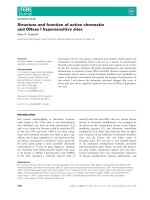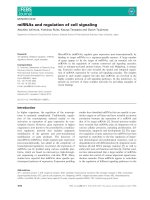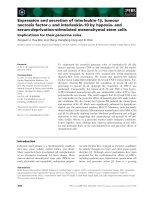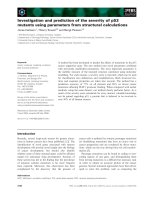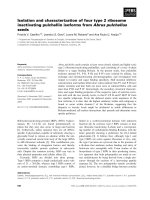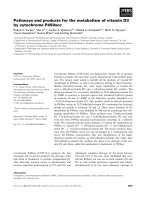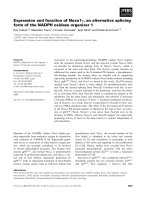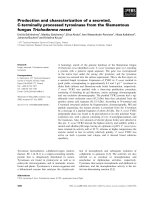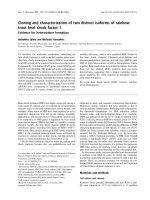Báo cáo khoa học: "Measurement and modelling of the photosynthetically active radiation transmitted in a canopy of maritime pine P Hassika" doc
Bạn đang xem bản rút gọn của tài liệu. Xem và tải ngay bản đầy đủ của tài liệu tại đây (754.29 KB, 16 trang )
Original
article
Measurement
and
modelling
of
the
photosynthetically
active
radiation
transmitted
in
a
canopy
of
maritime
pine
P
Hassika
P
Berbigier,
JM
Bonnefond
Laboratoire
de
bioclimatologie
Inra,
domaine
de
la
Grande-Ferrade,
BP
81,
33883
Villenave-d’Ornon
cedex,
France
(Received
20
May
1996;
accepted
20
May
1997)
Summary -
Modelling
the
photosynthesis
of
a
forest
requires
the
evaluation
of
the
quantity
of
pho-
tosynthetically
active
radiation
(PAR)
absorbed
by
the
crowns
and
the
understorey.
In
this
article
a
semi-empirical
model,
based
on
Beer’s
law
is
used
to
study
PAR
absorption
and
its
seasonal
varia-
tion.
Our
purpose
was
to
confirm
that
the
PAR
and
the
solar
radiation
follow
the
same
interception
laws
for
both
the
direct
and
diffuse
part,
using
correct
values
of
needle
transmission
and
reflection
coef-
ficients.
The
model
developed
took
into
account
the
direct
and
the
diffuse
radiation.
The
radiation
rescattered
by
the
crowns
was
neglected
following
an
estimation
using
the
Kubelka-Munk
equa-
tions,
which
indicated
that
the
term
was
small.
The
model
was
calibrated
and
tested
from
the
mea-
surements
taken
in
a
maritime
pine
forest
during
the
summer
and
autumn
of
1995.
The
comparison
between
the
results
of
the
model
and
the
measurements
was
satisfactory
for
the
direct
radiation
as
well
as
for
the
diffuse
radiation.
In
conclusion,
although
the
measurement
wavebands
are
different, the
pen-
etration
of
the
PAR
can
be
estimated
using
the
same
simple
semi-empirical
model
already
estab-
lished
for
solar
radiation.
model / solar
radiation
/
photosynthetically
active
radiation
/
penetration
/
maritime
pine
Résumé —
Mesure
et
modélisation
du
rayonnement
utile
à
la
photosynthèse
transmis
dans
un
couvert
de
pin
maritime.
Pour
la
modélisation
de
la
photosynthèse
d’un
couvert
végétal,
il
est
important
de
connaître
la
quantité
de
rayonnement
utile
à
la
photosynthèse
(PAR)
absorbé
par les
cou-
ronnes
et le
sous-bois.
Dans
cet
article,
un
modèle
semi-empirique,
exploitant la
loi
de
Beer,
ainsi
que
les
variations
saisonnières
du
PAR
sont
présentés.
L’objectif
de
l’étude
est
de
confirmer
que
le
rayonnement
utile
à
la
photosynthèse
et le
rayonnement
solaire
suivent les
mêmes
lois
d’interception
pour
le
direct
et
pour
le
diffus
en
intégrant les
valeurs
mesurées
de
reflectance
et
de
transmitance.
Le
modèle
établi
prend
en
compte
le
rayonnement
direct
et
le
rayonnement
diffus.
Le
rayonnement
*
Correspondence
and
reprints
Tel: (33)
05 56 84 31
87;
fax: (33)
05
56
84
31
35;
e-mail:
rediffusé
par
le
houppier
est
estimé
à
partir
des
équations
de
Kubelka-Munk.
Lorsque
ce
terme
est
négligé,
on
montre
que
l’erreur
induite
sur
le
bilan
radiatif est
faible.
Les
entrées
du
modèle
sont
déduites
des
mesures
effectuées
sur
une
forêt
de
pin
maritime
durant
l’été
et
l’automne
1995.
La
comparaison
entre
les
résultats
du
modèle
et
les
mesures
est
satisfaisante
aussi
bien
pour
le
rayonnement
direct
que
pour
le
rayonnement
diffus.
En
conclusion,
bien
que
les
ordres
de
grandeurs
et
les
domaines
spectraux
des
mesures
soient
différents,
la
pénétration
du
rayonnement
utile
à
la
photosynthèse
peut
être
estimé
par
un
simple
modèle
semi-empirique
déjà
établi
pour
le
rayonnement
solaire.
modèle
/
rayonnement
solaire
/
rayonnement
utile
à
la
photosynthèse
/
pénétration
/
pin
maritime
INTRODUCTION
Studying
the
evapotranspiration
and
the
pho-
tosynthesis
of
plants
is
useful
in
many
fields,
such
as
plant
physiology,
biomass
produc-
tion
on
a
large
scale
and
interaction
with
the
overall
climate
of
the
earth.
When
extrapolating
from
a
foliage
element
to
the
whole
plant,
the
interception
profile
of
radi-
ation
has
the
largest
vertical
gradient,
and
is
thus
essential
for
scaling-up.
In
forest
canopies,
in
contrast,
vertical
gradients
of
temperature,
concentration
of
water
vapour
and
CO
2
are
very
low.
The
photosynthetic
activity
depends
first
of
all
on
the
photo-
synthetically
active
radiation
(PAR)
inter-
cepted
and
the
combined
effects
of
water
vapour
concentration
and
air
temperature.
Internal
CO
2
concentrations
in
the
intercel-
lular
spaces
of
the
leaves
and
the
water
stress
of
the
canopy
also
play
a role
(Jones,
1992).
The
numerous
interception
models
of
radiation
by
plants
vary
from
simple
mod-
elling
based
on
Beer’s
law
(Bonhomme
and
Varlet-Grancher,
1977)
to
more
complex
models
characterized
by
a
discretization
of
the
canopy
into
elementary
volumes
or
cells.
These
cells
have
a
known
geometrical
shape
and
a
known
location
in
space.
In
general,
these
models
do
not
take
the
multiple
scat-
tering
between
these
different
cells
into
account.
These
cells
can
be
ellipsoids
(Nor-
man
and
Welles,
1983),
cones
(Wang
and
Jarvis,
1990),
rows
of
cylinders
and
cones
(Jackson
and
Palmer,
1972),
ellipsoids
(Charles-Edwards
and
Thorpe,
1976),
or
parallelepipeds
(Sinoquet,
1993).
A
Monte-
Carlo
simulation
can
be
used
to
calculate
the
direct
solar
radiation
at
different
points
in
a
canopy
(Oker-Blom,
1984).
However,
very
few
studies
have
focused
on
the
photosynthetically
active radiation
(PAR)
of
the
solar
spectrum
(Sinclair
and
Lemon,
1974;
Sinclair and
Knoerr,
1982;
Pukkala
et
al,
1991
). Other
teams
(Alados
et
al,
1995 ;
Papaioannou
et
al,
1996)
have
studied
the
relationship
between
the
PAR
and
the
solar
radiation.
These
studies
tend
to
show
that
the
ratio
between
the
PAR
and
the
solar
radiation
depends
on
solar
eleva-
tion,
sky
conditions
and
dewpoint
tempera-
ture.
Spitters
et
al
(1986)
also
established
an
empirical
relationship
between
global
and
diffuse
PAR.
In
this
paper
we
applied
the
model
devel-
oped
by
Berbigier
and
Bonnefond
(1995)
for
solar
radiation
on
a
forest
canopy
(Les
Landes,
France)
to
the
PAR.
The
objective
of
this
model
is
to
predict
the
proportion
of
direct
and
diffuse
PAR
reaching
the
under-
storey
using
measurements
of
incident
global
and
diffuse
PAR
above
the
canopy.
This
very
simple
semi-empirical
model
rep-
resents
the
canopy
as
a
horizontally
homo-
geneous
diffusing
layer.
The
direct
and
dif-
fuse
radiation
penetrates
according
to
Beer’s
law.
The
scattered
radiation
is
estimated
from
the
Kubelka-Munk
( 1931 )
equations,
which
have
also
been
used
by
Bonhomme
and
Varlet-Grancher
(1977).
This
model
is
semi-empirical
since
the
extinction
coeffi-
cient
is
adjusted
from
measurements.
The
outputs
of
the
model
were
validated
using
data
collected
during
a
series
of
mea-
surements
in
summer
and
autumn
1995.
In
this
paper
we
divide
the
global
PAR
or
incident
PAR
into
a
direct
part
(direct
PAR)
and
a
diffuse
part
(diffuse
PAR).
The
reflected
to
incident
PAR
ratio
will
be
called
PAR
reflectance.
MATERIAL
AND
METHODS
Experimental
data
were
collected
during
sum-
mer
1995
in
a
maritime
pine
forest
planted
in
1969.
The
plantation
is
located
20
km
south-west
of
Bordeaux
(latitude
44°
42’
N,
longitude
0°
46’
W).
On
a
1-ha
stand,
the
trees
were
planted
in
par-
allel
rows.
The
mean
height
of
the
trees
was
approximately
16
m.
The
maximum
height
was
18
m
and
the
mean
height
of
the
bases
of
the
crowns
was
9
m.
Tree
density
was
660
trees
per
hectare.
The
soil
was
completely
covered
with
clumps
of
grass
approximately
0.7
m
high,
which
were
completely
green
at
the
time
of
measure-
ments.
In
a
first
approximation
this
forest
can
be
described
by
two
distinct
plant
-layers,
ie,
the
crowns
of
the
pines
and
the
gramineae
of
the
understorey.
The
trees
were
planted
along
an
axis
NE-SW.
The
leaf
area
index
(LAI)
varied
between
3.4
and
3
during
the
measurement
sea-
son
(July-October).
This
LAI
was
measured
using
a
Demon
system
(Lang,
1987),
according
to
the
method
proposed
by
Lang
et
al
(1991)
where
the
total
surface
area
index
was
estimated
from
gap
frequencies.
These
frequencies
were
deduced
from
the
penetration
of
direct
sunbeams.
This
method
is
based
on
Cauchy’s
theorems
(Lang, 1991).
Measurements
of
the
photosynthetically
active
radiation
The
tools
generally
used
for
measuring
PAR
are
cells
containing
crystalline
silicon,
such
as
those
manufactured
by
Licor
(LI
190S),
which
respond
almost
instantaneously
to
small
or
sudden
vari-
ations
in
light
intensity.
For
this
experiment,
25
cells
were
prepared
in
the
laboratory
using
the
method
developed
by
Chartier
et
al
(1993).
These
sensors
delivered
a
voltage
proportional
to
the
incident
radiation.
To
measure
this
potential
difference
we
used
a
resis-
tance
of
18
ohms.
To
reduce
the
specular
reflec-
tion,
a
tarnished
filter,
which
only
allowed
the
spectrum
between
400
and
700
nm
to
pass,
was
stuck
above
each
cell.
A
number
of
sensors
were
mounted
above
the
canopy
on
a
25-m-high
scaffolding.
At
this
level
at
the
end
of a 2-m-long
rod,
two
cells,
one
facing
upward
and
the
other
downward,
mea-
sured
the
global
PAR
and
the
reflected
PAR.
On
the
same
site,
at
2
m
above
the
ground
and
at
the
top
of
the
scaffolding,
two
cells
locally
measured
the
diffuse
PAR
below
and
above
the
canopy,
respectively.
The
diffuse
PAR
was
obtained
by
using
a
shadow
band,
which
stopped
the
direct
PAR.
The
error
induced
on
the
mea-
surement
was
small:
to
account
for
the
effect
of
the
part
of
the
sky
vault
hidden
by
the
shadow
band,
a
multiplier
of
1.084
given
by
the
manu-
facturer
was
applied.
At
1 m
above
the
ground,
a
trolley
rolling
at
a
speed
of
2
m/min
on
a
22-m
railway
parallel
to
the
row
carried
five
two-sided
(one
facing
upward
and
one
facing
downward)
sensors
located
on
a
transversal
rod
whose
length
was
equal
to
the
width
of
the
inter-row
(4
m).
Every
15
min
this
experimental
device
calculated
the
mean
of
the
values
measured
every
10
s (Bonnefond,
1993).
This
system
allowed
us
to
perform
a
space-time
average
of
the
measurements
and
to
smooth
the
effect
of
the
rows.
Cells
were
calibrated
against
a
CM11,
Kipp
and
Zonen
thermopile
during
very
clear
weather
and
at
maximum
solar
elevation.
Under
these
conditions
it
is
possible
to
calibrate
quantum
sen-
sors
against
solar
energy
sensors
because
the
spectrum
distribution
of
the
solar
energy
remains
constant
(Varlet-Grancher et
al,
1981).
In
inter-
national
units
(SI)
the
density
of
the
solar
energy
flow
is
measured
in
watts
per
square
meter
(W.m
-2).
The
flux
density
of
the
PAR
(photo-
synthetic
photon
flux
density
(PPFD):
400-700
nm)
is
usually
defined
in
moles
of
photons
per
surface
unit
and
per
unit
of
time
(photon.m
-2.s-1).
We
found
that,
in
the
case
of
clear
days,
2.02
μmol
m
-2
s
-1
of
PAR
were
equal
to
1
W.m
-2
of
global
radiation.
All
sensors
had
similar
calibration
coeffi-
cients.
In
order
to
avoid
any
measurement
error
due
to
sensor
failure
(ageing,
loss
of
sensitivity,
contact
defect)
a
new
calibration
was
made
under
similar
conditions
at
the
end
of the
season.
Results
appeared
to
be
identical.
In
parallel
with
PAR
measurements,
the
net
and
global
radiation
above
the
forest
as
well
as
its
PAR
reflectance
were
measured
for
the
whole
solar
spectrum
(table I).
Data
were
recorded
on
a
data
acquisition
sys-
tem
of
the
Campbell
21X
type
(Campbell
Sci-
entific,
Logan,
UT).
As
for
the
mobile
measure-
ments,
the
recorded
values
were
the
15-min
average
of
measurements
taken
every
10
s.
For
this
study
we
had
a
complete
set
of
mea-
surements
(direct
and
diffuse
PAR
at
the
lower
and
higher
levels)
for
clear
days
189
and
193.
For
days
275, 279,
280
and
281
(clear
sky)
the
measurement
of
the
lower
diffuse
radiation
was
missing.
We
also
had
a
complete
set
of
measurements
for
two
days
with
a
partially
or
totally
overcast
sky
(190
and
192).
Lastly,
for
days
247,
249,
250,
265-273,
276-278
and
282
(totally
or
partially
overcast
days)
the
measurement
of
the
lower
diffuse
PAR
was
missing,
whereas
for
days
187, 188,
191
and
194-198
the
measurement
of
the
lower
global
PAR
was
missing.
The
direct
PAR
above
the
canopy
Rb
(0)
was
obtained
by
the
difference
between
the
mea-
surements
of
the
diffuse
and
global
PAR
above
the
canopy:
Rb
(0)
=
Rs
(0) -
Rd
(0).
THEORY
The
forest
of
Les
Landes
is
modelled
as
two
well-separated
plant
layers,
ie,
the
under-
storey
and
the
crowns.
We
focused
on
the
amount
of
PAR
transmitted
through
the
crown
layer.
This
theory
has
already
been
developed
for
solar
radiation,
by
Berbigier
and
Bon-
nefond
(1995).
The
aim
of
the
model
is
to
calculate
the
PAR
transmitted
and
absorbed
from
measurements
of
the
incident
direct
and
diffuse
PAR.
Non-intercepted
direct
PAR
The
non-intercepted
direct
PAR
is
simply
modelled
by
Beer-Bouguer’s
law,
which
can
be
written
as:
where
Rb
(λ)
(μmol
m
-2
s
-1
)
is
the
direct
PAR
at
a
given
level
within
the
crown,
Rb
(0)
is
the
direct
PAR
above
the
canopy,
λ
is
the
LAI
integrated
from
the
top
of
the
canopy
to
the
point
where
Rb
(λ)
is
defined,
β is
the
solar
elevation
angle
and
K
a
non-dimen-
sional
extinction
coefficient.
When
the
whole
crown
is
considered,
λ
=
L
is
the
LAI
of
the
canopy.
Thus,
when
using
Beer’s
law,
the
only
parameter
required
is
the
extinc-
tion
coefficient
(K)
of
the
canopy.
Non-intercepted
diffuse
PAR
Distribution
laws
of
luminance
corre-
sponding
to
clear
or
overcast
lighting
con-
ditions
are
very
different.
For
the
sake
of
simplicity
we
used
the
standard
overcast
sky
(SOC)
law
proposed
by
Steven
and
Unsworth
(1980).
For
clear
weather,
strictly
speaking
this
law
is
not
correct
because
there
is
a
strong
circumsolar
diffuse
PAR.
How-
ever,
since
the
diffuse
PAR
represents
only
approximately
15%
of
the
global
PAR,
this
error
is
acceptable
as
a
first
approximation.
The
expression
of
this
law
proposed
by
Steven
and
Unsworth
(1980)
is:
where
N(β,&phis;)
is
the
luminance
value,
N(π/2,0)
the
luminance
value
at
zenith
and
the
angular
source
azimuth.
Rd
(0)
is
the
mea-
sured value
of
the
incident
diffuse
PAR.
As
a
consequence
of
equation
[2], the
density
of
the
diffuse
PAR
above
the
canopy
is
written:
where u = sinβ.
This
integral
has
no
analytical
solution.
However,
its
numerical
value
can
be
closely
adjusted
to
a
function
Y =
exp(-K’λ)
using
the
least-squares
method
(Berbigier
and
Bonnefond,
1995).
We
obtained
K’
=
0.467.
Scattered
PAR
Measurements
showed
that
the
diffuse
PAR
reaching
the
understorey
is
spatially
homo-
geneous
even
in
a
discontinuous
canopy.
As
with
the
non-intercepted
PAR,
the
rescat-
tered
radiation
can
be
treated
a
fortiori
with
the
hypothesis
that
the
canopy
is
continu-
ous.
The
method
consists
in
writing
the
radi-
ation
balance
of
an
elementary
horizontal
layer
with
a
thickness
dλ.
The
rescattered
radiation
depends
on
the
reflectance
and
the
transmittance
of
the
foliage
elements
(ρ
and
τ)
as
well
as
on
the
PAR
reflectance
of
the
understorey.
Reflectance
(p)
and
transmit-
tance
(τ)
in
the
PAR
waveband
on
needles
of
maritime
pines
have
already
been
measured
by
Berbigier
and
Bonnefond
(1995)
The
scattered
radiation
was
deduced
for
each
elementary
layer,
when
the
radiation
bal-
ance
is
integrated
from
λ
=
0
to
λ
=
L.
These
values
made
it
possible
to
obtain
the
total
diffuse
PAR
of
the
crown
(Bonhomme
and
Varlet-Grancher,
1977;
Sinoquet
et
al,
1993).
The
analytical
solution
of
these
equations
was
given
by
Bonhomme
and
Varlet-
Grancher
(1977)
for
a
canopy
of
maize
when
p
=
τ
and
by
Berbigier
and
Bonnefond
(1995)
for
a
canopy
of
maritime
pines
when
ρ ≠ τ.
We
used
the
solution
established
by
the
last
authors.
RESULTS
AND
DISCUSSION
Experimental
measurements
Figure
I
shows
the
different
terms
of
the
radiation
balance
in
the
PAR
above
and
below
the
canopy
for
clear
weather
(day
193)
as a
function
of
the
hour
of
the
day.
The
transmission
of
the
incident
PAR
varies
with
the
solar
elevation
and
is
much
lower
for
low
incident
angle
incidences.
Apart
from
a
cloudy
period
at
approximately
1400
hours
UT,
which
explains
the
fall
in
the
global
PAR
and
the
increase
in
the
incident
diffuse
PAR,
the
curves
show
the
expected
shape.
The
incident
global
PAR
reached
a
maximum
of
approximately
1900
μmol.m
-2.s-1
in
the
middle
of
the
day.
The
global
PAR
below
the
crowns
reached
a
peak
at
approximately
700
μmol.m
-2.s-1
around
1300
hours
(denoted
’1’
in
fig
1),
which
corresponds
to
the
presence
of
the
sun
between
the
rows.
The
effects
of
the
two
adjacent
rows
of
crowns
can
also
be
seen
on
the
measurements
(denoted
’2’
in
fig
1).
To
estimate
the
scattered
PAR
it
is
nec-
essary
to
know
the
PAR
reflectance
of
the
understorey.
This
PAR
reflectance
is
defined
as
the
ratio
between
incident
PAR
and
reflected
PAR.
An
example
of
variations
with time
for
a
day
of
measurements
of
the
PAR
reflectance
of
the
canopy
and
the
understorey
is
presented
in
figure
2.
The
increase
in
the
canopy
PAR
reflectance
at
the
beginning
and
at
the
end
of
the
day
is
due
to
the
interception
of
the
top
of
the
plant
canopy.
For
this
day
the
average
PAR
reflectance
above
this
forest
reached
approximately
0.06.
This
value
represents
less
than
half
of
the
PAR
reflectance
of
the
solar
radiation
when
the
whole
spectrum
is
taken
into
account
(fig
2).
Although
this
value
seems
low,
this
result
is
coherent
with
another
study
(Gash
et
al,
1989).
For
the
understorey
PAR
reflectance
the
values
at
the
beginning
and
the
end
of
the
day
are
not
representative
because
the
values
of
the
reflected
PAR
are
extremely
low
(less
than
3
μmol
m
-2
s
-1).
When
the
understorey
average
PAR
reflectance
could
be
measured,
it
reached
approximately
0.05.
The
daily
value of
the
canopy
PAR
reflectance
is
defined
as
the
ratio
between
the
sum
of daily
incident
PAR
and
the
sum
of
daily
reflected
PAR
above
the
canopy.
We
deduce
PAR
reflectance
and
the
ratio
of
incident
diffuse
PAR
on
incident
global
PAR
by
using
the
daily
sums,
since
the
direct
PAR
depends
more
closely
on
the
solar
elevation
angle.
In
figure
3a
a
regular
increase
in
the
canopy
PAR
reflectance
was
observed
on
the
forest,
during
the
seasonal
measurement.
The
forest
PAR
reflectance
reached
approx-
imately
0.05
at
the
beginning
of
July
and
0.07
at
the
beginning
of
October.
This
increase
could
be
due
to
the
increased
stand
reflectivity
at
low
incidences,
which
has
already
been
mentioned,
and
perhaps
to
the
death
of
3-year
old
needles.
Figure
3b
shows
the
variation
curve
of
the
understorey
PAR
reflectance.
A
maxi-
mum
can
be
observed
in
the
mean
value
between
days
235
and
255.
This
increase
was
possibly
due
to
a
short
period
of
water
deficiency
in
the
summer
of
1995:
the
graminea
were
dry
and
had
lost their
green
colour
unlike
the
needles
which
remained
green.
After
rainfall,
a
decrease
was
observed.
The
mean
forest
and
understorey
PAR
reflectance
was
0.06
and
0.05,
respec-
tively,
over
this
period.
These
two
values
of
the
PAR
reflectance
are
not
additive
because
the
reflected
PAR
above
the
canopy
is
not
the
sum
of
the
PAR
reflected
by
the
understorey
and
crowns.
Variations
in
diffuse
PAR
and
global
PAR
daily
means
are
presented
in
figure
4
for
the
period
from
5
July
to
9
October
1995
(days
186-282).
It
shows
a
divergence
between
the
trends
of
the
global
and
the
dif-
fuse
PAR,
probably
due
to
the
mean
decrease
in
solar
elevation.
Since
the
ratio
between
the
diffuse
and
global
PAR
pre-
sents
more
intra-day
variations,
we
do
not
show
a
curve
of
the
15-min
ratios,
which
were
much
more
variable.
Table
II
shows
the
values
of
the
propor-
tions
between
the
diffuse
PAR
and
the
global
PAR,
which
were
measured
for
clear
and
variable
weather
throughout
the
season.
For
clear
days
the
density
of
the
diffuse
PAR
represented
approximately
15%
of
the
global
PAR.
This
ratio
was
40%
for the
variable
and
30%
for
all
the
days.
These
val-
ues
imply
that
the
proportion
of
diffuse
PAR
in
the
global
PAR
was
almost
equivalent
to
the
proportion
of
diffuse
radiation
in
the
global
solar
radiation.
This
result
has
to
be
compared
to
other
studies
(Efimova,
1967)
which
suggest
that
the
PAR
can
be
estimated
from
measure-
ments
of
radiation
with
short
wavelengths
using
the
following
relation:
The
difference
observed
in
our
study
(30%
versus
57%
in
the
former)
can
be
explained
by
the
fact
that
our
study
was
performed
during
a
rather
sunny
part
of
the
year.
A
more
precise
estimation
of
these
values
is
currently
being
studied.
However,
since
measuring
the
diffuse
PAR
routinely
is
relatively
complicated,
it
is
also
of
interest
to
search
for
a
semi-empiri-
cal
relation
between
the
diffuse
PAR
and
the
global
PAR,
which
could
avoid
mea-
suring
the
diffuse
PAR.
Spitters
et
al
( 1986)
also
established
an
empirical
relationship
between
global
and
diffuse
PAR,
taking
into
account
sunshine
duration.
Unlike
the
solar
radiation
this
type
of
relation
has
never
been
established
for
PAR
in
our
region.
This
rela-
tionship
is
currently
being
studied
in
our
laboratory.
Modelling
The
model
was
adjusted
on
three
days
with
clear
and
overcast
sky
(days
189,
190,
192)
for
which
all
the
data
were
available.
These
days
were
chosen
close
to
the
summer
sol-
stice
in
order
to
have
a
maximum
variation
in
the
solar
height.
The
different
parts
of
the
model
were
then
validated
with
the
corre-
sponding
measurements
of
the
other
days
between
days
188
and
282.
Direct
radiation
The
extinction
coefficient
K
of
the
foliage
elements
can
be
deduced
from
Beer’s
law
and
written
as:
where
Rb
(0)
and
Rb
(λ)
represent
the
direct
PAR
below
and
above
the
crowns,
respec-
tively.
In
figure
5
a
relationship
between
K
and
the
angles
of
solar
elevation
is
observed.
Strictly
speaking,
K
cannot
be
assumed
con-
stant
since
it
varies
with
sun
angular
eleva-
tion
(de
Wit,
1965).
On
days
189,
190
and
192
K was
calcu-
lated
for
solar
elevation
angles
greater
than
30°.
The
mean
values
are
given
in
table
III.
The
overall
average
is:
On
the
same
experimental
site
Berbigier
and
Bonnefond
(1995)
have
found
the
same
value
in
a
study
of
solar
radiation.
Conse-
quently,
with
the
same
hypotheses,
Beer’s
law
in
this
forest
has
a
unique
extinction
coefficient
for
the
PAR
as
well
as
the
solar
radiation.
However,
without
assuming
that
the
foliage
index
is
horizontally
homogeneous,
the
effect
of
the
angular
distribution
of
the
needle
must
be
included.
Nevertheless
we
checked
this
using
the
ellipsoidal
distribution
of
the
needle
orientations
suggested
by
Campbell
(1986).
This
did
not
give
better
results,
which
justifies
the
use
of
a
constant
K.
Figure
6a
shows
a
comparison
between
the
measurements
of
the
direct
PAR
and
the
modelled
direct
PAR
using
equation
[6]
on
day
193.
Variations
in
the
direct
PAR
in
the
understorey
resulting
from
the
presence
of
rows
cannot
be
seen
from
the
results
of
the
model,
which
is
based
on
the
assumption
of
a
continuous
horizontal
canopy.
Figure
6b
gives
an
example
of
the
out-
puts
of
the
model
to
direct
PAR
measure-
ments
on
day
189.
It
compares
the
mea-
surements
and
the
outputs
of
the
model
for
one
of
the
days
used
to
adjust
equation
[1].
The
deviations
to
the
model
are
represented
with
a
linear
regression
forced
to
the
ori-
gin.
The
slope
of
this
line
is
0.95
for
R2
=
0.9.
An
increasing dispersion
is
observed
for
the
high
values,
which
is
due
to
rows.
However,
figure
7
shows
that
the
com-
parison
between
all
the
measurements
of
all
the
days
not
used
to
adjust
the
model
and
the
outputs
of
the
model
may
be
represented
with
a
linear
regression
forced
to
the
ori-
gin.
It
can
be
noted
that
the
model
slightly
overestimates
the
measurements
since
the
slope
of
this
line
is
0.96
for
R2
=
0.91.
This
bias
may
result
from
the
hypothesis
of
a
constant
K,
which
does
not
exactly
repre-
sent
the
reality.
Diffuse
PAR
The
diffuse
PAR
measured
below
the
canopy
is
the
sum
of
the
sky
diffuse
PAR
having
crossed
the
canopy
without
being
intercepted
and
the
PAR
scattered
by
the
elements
of
the
crown.
We
first
studied
the
scattered
part
of
the
PAR.
The
model
is
applied
for
evaluating
the
scattered
PAR
to
all
the
days.
The
values
obtained
are
lower
than
5
±
0.025
μmol.m
-2.s-1
on
average,
ie,
less
than
4%
of
the
lower
diffuse
radiation.
These
values
are
within
the
range
of
absolute
error
of
our
sensors.
Consequently,
part
can
be
neglected
when
modelling
the
radiation
transmitted
because
the
error
induced
is
lower
than
1
%
on
the
estimation
of
the
global
radiation
in
the
understorey.
The
rescattered
radiation
is
not
accounted
for
in
the
model.
It
was
shown
above
(equation
[3])
that
the
non-intercepted
diffuse
PAR
Rd
(λ)
at
depth λ
can
be
written
as:
Regarding
measurements
and
the
simula-
tion
of
day
193
(fig
8a),
the
orientation
of
the
rows
does
not
seem
to
affect
the
proportion
of
diffuse
PAR
transmitted
to
the
under-
storey.
The
simulation
example
shown
in
fig
8a
was
made
on
a
clear
day
(except
from
1400
to
1500
IST)
in
order
to
suppress
the
disruptive
effects
of
the
clouds.
Figure
8b
shows
that
the
diffuse
PAR
is
homogeneous.
Thus,
the
diffuse
radiation
smooths
the
effect
of
the
rows.
A
linearity
defect
between
the
measurements
and
the
model
can
be
seen.
This
bias
may
result
from
the
hypothesis
of
a
constant
K,
which
would
affect
K’.
However,
this
angle
was
observed
on
clear
days,
where
the
diffuse
PAR
was
very
small
(150
μmol.m
-2.s-1
at
maximum).
The
model
was
validated
on
all
the
days
not
used
to
adjust
the K
coefficient
and
for
which
the
lower
diffuse
PAR
was
measured.
Predictions
were
in
agreement
with
the
mea-
surements
and
the
maximum
difference
with
the
line
1:1
was
approximately
26
μmol.m
-2.s-1
(fig
9).
Global
PAR
The
outputs
of
the
complete
model
can
now
be
compared
to
the
measurements
of
the
global
PAR
(fig
10)
for
all
the
experimental
days
where
this
measurement
is
available
(1
350
points).
A
good
agreement
is
observed
(R
2
=
0.94)
in
spite
of
a
slight
underestimation
(slope
0.9),
which
may
be
due
to
geometrical
effects
of
the
crowns
(rows,
holes,
preferential
orientations
of
the
foliage
elements).
CONCLUSION
Since
the
penetration
of
the
PAR
into
plant
canopies
is
poorly
documented,
we
tried,
in
this
paper,
to
apply
a
semi-empirical
model
to
the
PAR.
This
model
was
previously
established
for
the
solar
radiation
in
a
forest
of
maritime
pines.
The
daily
variations
of
the
incident
and
transmitted
PAR
were
pre-
sented.
A
regular
increase
in
the
canopy
PAR
reflectance
was
observed,
during
the
mea-
surement
season.
This
value,
approximately
0.05
at
the
beginning
of
July,
reached
0.065
in
October.
During
the
same
time,
for
under-
storey
PAR
reflectance
an
increase
in
the
mean
value
between
days
235 and
255
could
be
observed.
This
increase
was
due
to
a
short
period
of
water
deficiency.
Later
we
showed
that
the
reflectivity
of
the
canopy
was
much
lower
in
the
PAR
than
for the
whole
solar
waveband.
The
proportions
between
the
diffuse
PAR
and
the
global
PAR,
which
were
measured
by
clear
and
variable
weather
throughout
the
season,
were
compared.
The
diffuse
PAR
represented
approximately
30%
of
the
global
PAR.
The
outputs
of
the
model
of
the
direct
PAR
and
the
diffuse
PAR
transmitted
to
the
soil
showed
a
good
correlation
with
the
sea-
sonal
measurements.
This
result
enables
us
to
state
that
this
model
is
a
good
tool
for
predicting
the
interception
of
the
PAR
in
the
forest,
ie,
the
partition
of
PAR
between
crowns
and
understorey.
In
a
first
approximation,
the
extinction
coefficient K
is
constant.
The
daily
outputs
of
the
model
of
the
direct
PAR
and
the
dif-
fuse
PAR
transmitted
to
the
soil
were
not
in
agreement
with
measurements,
but
more
models
of K
will
be
tested
after-
wards.
Nevertheless,
this
model
may
be
useful
for
ecophysiological
studies.
Acknowledgements:
The
authors
thank
Y
Brunet,
I
Champion
and
M
Irvine
for
proof-read-
ing
this
article
as
well
as
A
Kruszewski
for
con-
structing
and
installing
sensors
on
the
experi-
mental
site.
This
work
was
partially
supported
by
the
Conseil
regional
of Aquitaine.
REFERENCES
Alados
I,
Foyo-Moreno
I,
Alados-Arboledas
L
(1995)
Photosynthetically
active
radiation:
measurements
and
modelling.
Agric
For
Meteorol 78,
121-131
Berbigier
P,
Bonnefond
JM
(1995)
Measurement
and
modelling
of
radiation
transmission
within
a
stand
of
maritime
pine
(Pinus
pinaster
Ait).
Ann
Sci
For
52, 23-42
Bonhomme
R,
Varlet-Grancher
C
(1977)
Application
aux
couverts
végétaux
des
lois
de
rayonnement
en
milieu
diffusant.
I.
Établissement
des
lois
et
véri-
fications.
Ann
Agro
28,
567-582
Bonnefond
JM
(1993)
Études
d’un
système
mobile
destiné
à la
mesure
du
rayonnement.
Application
à
la
mesure
du
rayonnement
global
et
du
rayonnement
net
sous
un
couvert
de
pins
maritimes.
Cah
Tech
Inra 30,
13-32
Campbell
GS
(1986)
Extinction
coefficients
for
radia-
tion
in
plant
canopies
calculated
using
an
ellip-
soidal
inclination
angle
distribution.
Agric
For
Meteorol 36, 317-321
Charles-Edwards
DA,
Thorpe
MR
(1976)
Interception
of
diffuse
and
direct-beam
radiation
by
a
hedgerow
apple
orchard.
Ann
Bot
44,
603-613
Chartier
M,
Allirand
JM,
Varlet-Grancher
C
(1993)
Canopy
radiation
balance:
its
components
and
their
measurement.
In:
Crop
Structure
and
Light
Micro-
climate
(C
Varlet-Grancher,
R
Bonhomme,
H
Sino-
quet,
eds),
Inra
Versailles,
France,
29-43
Efimova
N
(1967)
Photosynthetically
active
radiation
over
the
USSR.
In:
Plant
Photosynthetic
Production
Manual
of Methods
(Z
Sestak,
J
Catsky,
PG
Jarvis,
eds),
Dr
W.
Junk
NV,
412-466
Gash
JHC,
Shuttleworth
WJ,
Lloyd
CR,
André
JC,
Goutorbe
J-P,
Gelpe
J
(1989)
Micrometeorological
measurements
in
les
Landes
forest
during
Hapex-
Mobilhy.
Agric
For
Meteorol 46,
131-147
Jackson
JE,
Palmer
JW
(1972)
Interception
of light
by
model
hedgerow
orchards
in
relation
to
latitude,
time
of
year
and
hedgerow
configuration
and
ori-
entation.
Appl
Ecol 9,
341-357
Jones
HG
(1992)
Photosynthesis
and
respiration.
In:
Plants
and
Microclimate.
A
Quantitative
Approach
to
Environmental
Plant
Physiology,
2
ed.
Cam-
bridge
Univ
Press,
Cambridge
Kubelka
P,
Munk
F
(1931)
Ein
Beitrag
zur
Optik
der
Farbanstriche.
Zeits
Furtechn
Physick
12,
593
Lang
ARG
(1987)
Simplified
estimate
of
leaf
area
index
from
transmittance
of
the
sun’s
beam.
Agric
For
Meteorol 41,
179-186
Lang
ARG,
McMurtie
RE,
Benson
ML
(1991)
Valid-
ity of
surface
area
indices
of
Pinus
radiata
esti-
mated
from
transmittance
of
the
sun’s
beam.
Agric
For
Meteorol
55
Lang
ARG
(1991)
Application
of
some
of
Cauchy’s
theorems
to
estimation
of
surface
areas
of
leaves,
needles
and
branches
of
plants,
and
light
transmit-
tance. Agric
For
Meteorol
55,
191-212
Norman
JM,
Welles
JM
(1983)
Radiative
transfer
in
an
array
of
canopies.
Agron
J
75,
481-488
Oker-Blom
P
(1984)
Penumbral
effects
of within-plant
and
between-plant
shading
on
radiation
distribu-
tion
and
leaf
photosynthesis:
a
Monte-Carlo
simu-
lation.
Photosynthetica
18, 522-528
Papaioannou
G,
Nikolidakis
G,
Asimakopoulos
D,
Retalis
D
(1996).
Photosynthetically
active
radiation
in
Athens.
Agric
For
Meteorol,
81, 287-298
Pukkala
T,
Becker
P,
Kuuluvainen
T,
Oker-Blom
P
(1991 )
Predicting
spatial
distribution
of
direct
radi-
ation
below
forest
canopies.
Agric
For
Meteorol
55, 295-307
Sinclair
TR,
Lemon
ER
(1974)
Penetration
of photo-
synthetically
active
radiation
in
corn
canopies.
Agron J 66, 201-205
Sinclair
TR,
Knoerr
KR
(1982)
Distribution
of photo-
synthetically
active
radiation
in
the
canopy
of
a
loblolly
pine
plantation.
J Appl Ecol 19,
183-191
Sinoquet
H
(1993)
Modelling
radiative
transfer
in
het-
erogeneous
canopies
and
intercropping
systems.
In:
Crop
Structure
and
Light
Microclimate
(R
Bon-
homme,
C
Varlet-Grancher,
H
Sinoquet,
eds),
Inra,
Versailles,
France,
229-252
Spitters
CJT,
Tousaint
HAJM,
Goudriaan
J
(1986).
Separating
the
diffuse
and
direct
component
of
global
radiation
and
its
implications
for
modelling
canopy
photosynthesis.
Part
I.
Components
of
incoming
radiation.
Agric
For
Meteorol 38, 217-229
Steven
MD,
Unsworth
MH
(1980)
The
diffuse
irradi-
ance
of
slopes
under
cloudless
skies.
QJR
Meteorol
Soc
105, 593-602
Varlet-Grancher
C,
Chartier
M,
Gosse
G,
Bonhomme
R
(1981)
Rayonnement
utile
pour
la
photosynthèse
des
végétaux
en
conditions
naturelles :
caractéri-
sation
et
variations.
Acta
Oecol
Plant
16,
189-202
Wang
YP
and
Jarvis
PG
(1990)
Description
and
vali-
dation
of
an
array
model
MAESTRO.
Agric
For
Meteorol
51, 257-280
de
Wit
CT
(1965)
Photosynthesis
of
leaf
canopies.
Agricultural
Research
Report
No
663,
Center
for
Agricultural
publication
and
documentation,
Wageningen,
the
Netherlands
